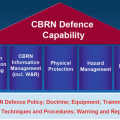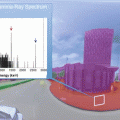© Springer Science+Business Media Dordrecht 2015
Samuel Apikyan and David Diamond (eds.)Nuclear Threats and Security ChallengesNATO Science for Peace and Security Series B: Physics and Biophysics10.1007/978-94-017-9894-5_1010. SCK•CEN’S Activities in the Field of CBRN Risk Mitigation: Practical Contributions to Improving Nuclear Security Governance
(1)
Nuclear Research Centre SCK•CEN, Mol, Belgium
Abstract
The Belgian Nuclear Research Centre SCK•CEN started activities in the framework of CBRN risk mitigation around 10 years ago. These activities were based on expertise on radiological and nuclear emergency management that was acquired over the years. The first activities focused on RN risks, in particular radiological dispersal devices or dirty bombs, followed by a more comprehensive study of the radiological risks and the countermeasures to be taken in the framework of a European FP6 R&D project called TMT Handbook. Present activities in CBRN risk mitigation of SCK•CEN have on the one hand a clear R&D component, mainly embedded in European research projects like e.g. the FP7 project CATO, and on the other hand a practical implementation component by leading or participating in several European projects (Centres of Excellence, Framework contracts for the Instrument for Stability) and providing advice and expertise to the national Belgian authorities. In this paper we will give an overview of all these activities and discuss some projects in more detail.
10.1 Introduction
Nuclear security has received an increasing amount of attention in the past decade. This attention has given rise to political action by various actors, of which the US and the EU are among the most important ones.
The term nuclear security in its strict interpretation is security of nuclear weapons and nuclear material that can be used for nuclear weapons. This was also the main scope of the Nuclear Security Summits, but the security of radioactive sources was also mentioned and gained some more attention in the course of time.
The instruments to improve nuclear security often have a broader scope than just nuclear. For instance, the European initiative of CBRN Centres of Excellence considers not only the nuclear threat, but all possibilities for obtaining weapons of mass destruction (chemical, biological, nuclear).
The activities of SCK•CEN in the framework of improving nuclear security are mainly sponsored by European instruments and therefore do not always only focus on nuclear security. Some activities apply to chemical and biological threat reduction.
10.2 EC Instruments
The EC has created many instruments to support its policies. The instrument that is used to support nuclear security is the Instrument contributing to Stability and Peace (IcSP), formally known as the Instrument for Stability (IfS). The general scope of the IcSP is in the areas of crisis response, conflict prevention, peace-building and crisis preparedness, and addresses global and trans-regional threats, both man-made and natural. The IcSP has a short-term and a long-term component. One of the long-term components is the CBRN Centres of Excellence that aims at mitigating CBRN risks by improving CBRN security in regions all over the world.
Whereas the IcSP implements projects based on existing European expertise in CBRN, the EC also supports research to improve CBRN security. This research is sponsored via the framework projects in the past and now via Horizon 2020. Several Directorate-Generals are participating in this support, for instance DG Security and DG Home.
10.3 The Nuclear Security Summits (NSS)
The basis of the Nuclear Security Summits was laid in the 2009 Prague speech of President Obama, where he urged for action on the threat of misuse of nuclear material for terrorist’s purposes. This resulted in the biannual organisation of the Nuclear Security Summits (2010 Washington, 2012 Seoul, 2014 The Hague). During these summits, actions are agreed upon to diminish the threat of the presence of nuclear and radiological material and these actions are discussed and evaluated during the next NSS. While nuclear material was the main focus at the start of the NSS, radioactive sources got more attention in the course of time. The next Nuclear Security Summit will be organised in the US. Examples of actions performed in this framework are the reduction of the use of Highly Enriched Uranium (HEU), reduction of HEU stockpiles, installation of detection equipment at borders to prevent illicit trafficking in nuclear and radioactive material and applying IAEA security standards in nuclear facilities.
10.4 Present Contributions of SCK•CEN to CBRN Risk Mitigation
SCK•CEN contributes in various ways to the reduction of CBRN risks. Its main contributions go via the EC Instrument contributing to Stability and Peace IcSP. Within this instrument, the CBRN Centres of Excellence play an important role for the SCK•CEN activities. Three projects for CBRN CoE are presently carried out, in which SCK•CEN plays a role. Furthermore SCK•CEN is leading a consortium for the so-called Expert Support Facility in lot 1 (CBRN Risk Mitigation). The EC can ask to provide on a short term experts for specific tasks in countries mainly outside the EU.
Another mayor contribution to CBRN risk reduction is done via research. SCK•CEN has participated or is participating in two R&D projects: TMT Handbook (FP5) and CATO (FP7).
In the framework of agreements within the Nuclear Security Summits SCK•CEN has removed nuclear material and transferred it to the USA.
10.4.1 CBRN Centres of Excellence Project 9: Lebanon
The main objective of the project was to enhance the national response plan in Lebanon. This enhancement dealt with legislative, organizational and practical implementation.
The Project Consisted of Five Work Packages
The first work package focused on the legislative and organizational part and included an assessment of the draft National Response Plan of Lebanon, followed by an assessment of the national response organization. The assessment was done following international examples and recommendations [1–4].
The second work package focused on organizational aspects, in particular on the development of Standard Operations Procedures (SOPs). Whereas the original idea was to assess available SOPs and provide recommendations for improvement, it appeared that SOPs did not yet exist. A procedure to develop SOPs, based on international guidance [5–11], was therefore written and a list of prioritised SOPs was identified. SOPs on this prioritised list should be developed first.
The third work package focused on the practical implementation of the response plan and SOPs. Guidance with respect to the development of table-top and field exercises has been developed for this purpose and provided to the beneficiary in the form of reports. Additionally a 5-day course has been delivered to representatives of the major stakeholders in national emergency planning and response in Lebanon. During this course vocational training was given related to more theoretical aspects of emergency response, while practical exercises were given to perform various table-top exercises in the CBRN field. Specific training in the tools HOTSPOT and RODOS was given to provide the knowledge and capacity to the Lebanese stakeholders to develop themselves new scenarios for table-top exercises. The Lebanese participants indicated that they preferred to organise a field exercise only after having participated as observer in a field exercise e.g. in Belgium. Since this was not possible within the present project, the performance of a field exercise was replaced by providing the European decision support system RODOS for radiological and nuclear emergencies. The Belgian national crisis centre was visited in the framework of the project.
Stay updated, free articles. Join our Telegram channel

Full access? Get Clinical Tree






